|
barcelona
|
location
of study area | main characteristics of
region | water supply |
water resources | water prices | water
quality | stakeholders
| major changes |
|
Water
in the Spanish Metropolitan Region of Barcelona is provided
by a variety of companies (public, semi-public and private).
Local, supra-local and regional institutions are in charge
of aspects such as sewers, flood control works and wastewater
treatment facilities. Part of the cost of these activities
is financed by consumers through taxes included in the water
bills. This makes Barcelona the most expensive city in Spain
for water. Over the last 8 years, a significant social revolt
has arisen in which some 80,000 families in the metropolitan
area refuse to pay the taxes included in their water bills.
The FIRMA project aims:
- To
understand the water problems (supply, quality) currently
faced by Barcelona
- To
assess the behaviour of the different stakeholders (consumers,
water companies, real estate developers, public institutions)
involved in the planning and management of the hydrological
cycle in this area
- To
evaluate alternative institutional and management strategies
for more socially (and environmentally) acceptable ways
of managing water resources
3
main issues
|
|
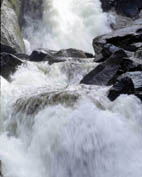
|
location
of study area |
| 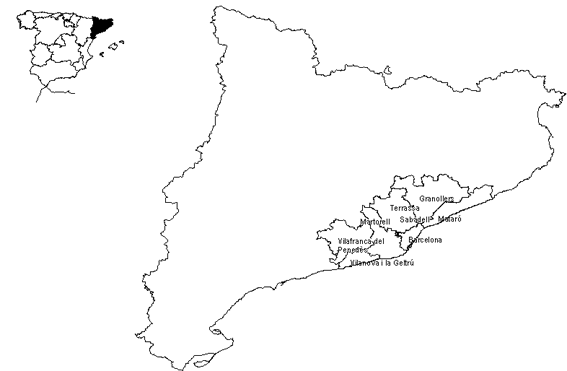
|
| 
main
characteristics of metropolitan region of barcelona
- The
Barcelona Metropolitan Region is divided in administrative terms
into seven "comarques" (equivalent to the English counties)
- Physiographic
patterns show a narrow coastal plain, occasionally widened by
river deltas, and a series of mountain ranges roughly parallel
to the coastline and separated by undulating plains.
- Climate
presents mild winters and warm summers, with a warming trend observed
in the 1990s. Precipitation values oscillate around 500-700 mm
a year, although means and averages make little sense in front
of strong inter-annual and intra-annual variations.
- Population
trends parallel the recent history of Mediterranean cities. That
is, rural migration and concentration of population in large cities
until approximately the mid 1970s, and the reverse processes in
the 1980s and 1990s. Thus, from centralized compact urban forms
and functions, the Barcelona region is undergoing a more dispersed
pattern with an increasing presence of features of what we call
the diffuse city (or "American model"): low density housing, a
communications network built for private transportation, and proliferation
of metropolitan subcenters.
fluvial
networks of the Barcelona metropolitan region
| River |
Basin
area (km2) |
Annual
mean average flow (m3/s) |
Minimum
flow in a dry year (m3/s) |
Maximum
flow (m3/s) |
Date
of maximum flow |
| Llobregat
- Matorell |
4 561 |
20.7 |
1.69 |
3 080 |
21-9-1971 |
| Besos
- Montcada |
1 032 |
3.88 |
1.8 |
2 345 |
25-9-1962 |
| Ripoll
- Montcada |
242 |
1.19 |
0.40 |
1 234 |
25-5-1962 |
| Tordera
- Can Serra |
802 |
5.65 |
0 |
1 280 |
20-9-1971 |
delta
of llobregat
The
Llobregat River creates a delta of about 100 sq. kilometers that
constitutes one of the most valuable natural areas of the Metropolitan
Region of Barcelona. Since the 1960s, these wetlands and also traditional
land uses such as agriculture have been under attack from the sea
(expansion of the Barcelona harbour), from the air (expansion of
the Barcelona airport ), and from the land (urbanization, industrialization,
a dense road network, etc.).
| Llobegrat
River
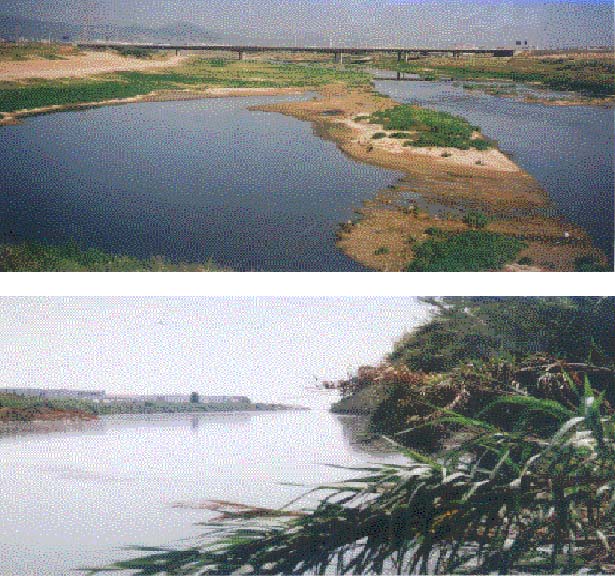

|
riera
de rubi
"Rieras"
are the Catalan name for short, ephemeral streams. The Riera of
Rubí is a good example of the fate of such streams in the Metropolitan
Region of Barcelona. After the disastrous flood of 1962 (which killed
almost 1 000 people in the region), this and other streams were
channelized and their floodplains developed for industrial and commercial
purposes. Due to the climatological and hydrological peculiarities
of Mediterranean ephemeral streams, the Riera of Rubí suffers from
extended periods of very low or unexisting flows occasionally altered
by much shorter and violent flood episodes. Moreover, in periods
of low flows the only water circulating in the stream comes from
wastewater plants.
| Riera
Rubi May 1997
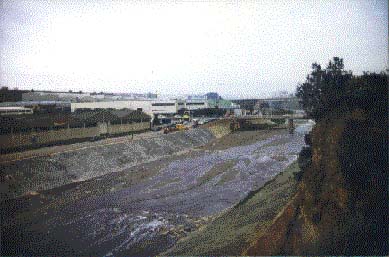
Riera
Rubi September 1971
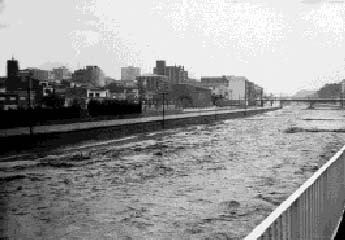
|
besos

|
|
extreme
events
-
Floods and droughts are a common characteristic of Mediterranean
water cycles. In the Barcelona region, there have been major floods
in 1962 (with possibly 1 000 people dead), 1971, 1988 and 1994.
Local flashflooding is becoming increasingly important, especially
in the rapidly growing coastal plains north and south of the city.
Diffuse inondation after storms with intensities of 200 mm/day
or more is also becoming common.
- Drought
conditions have become also more frequent in the 1990s. In 1990,
for instance, the region barely escaped the imposition of supply
restrictions. The winter of 1999-2000 has been in many localities
the driest winter of the century although, in accordance with
the Mediterranean climate, the following spring has been one of
the wettest of the last decade
water
supply sources
- To
1953: Groundwater
- 1953
- 1967: Groundwater and surface watre from Llobregat River
- 1967
- 2000: Groundwater and surface water from Llobregat River and
surface water from Ter River (water transfer approx. 100 kilometers
long)
The
regional government of Catalonia has studied since 1995 the
possibility of bringing water from the Roine River in France.
At this moment, the "Roine option" appears as the
most feasible in economic and environmental terms and, unlike
the case of the Ebro River, does not seem to have produced in
France a virulent opposition.

water
resources
- the
current structure demand shows that 61% of the water goes to domestic
consumption, 23% to industrial activities and 16% to agriculture.
Within the region, urban consumption appears to be declining in
the city of Barcelona and in the immediate municapilities (due
to population and industrial shifts) and growing rapidly in the
periphery.
- Balance
between supply and demand indicates that security margins are
below desirable levels and that area is prone to a water deficit
that is likely to become significant in 2010. Alternative sources
of supply (water re-use, desalinization and transfer from another
basin) are considered either unfeasible or insufficient by water
authorities.
water
prices
- The
23 municipalities of the Metropolitan Area of Barcelona have the
highest prices for water in Spain (with Murcia and Palma de Mallorca).
-
Whether this price is high or low depends obviously on family
incomes. In Barcelona, it has been estimated that the water bill
represents around 3 per cent of mean family budgets and may be
significant for the lower income households of the central city
and surrounding towns. Moreover, taxes represent a greater proportion
of the bill than the service itself. In fact, an important rise
in water taxes generated one of the most important social conflicts
happening in Barcelona in the 1990s, with some 80,000 families,
mostly from low income neighborhoods, refusing to pay these taxes.
water
quality
- At
the end of the 1980s, the rivers of the Barcelona region stood
as possibly the most polluted and degraded of Western Europe.
Since 1991 and after the European directive on urban wastewater,
a comprehensive program of water treatment plants has been implemented
and the situation has improved dramatically.
- Nevertheless,
the quality index used by the regional government only includes
physico-chemical parameters. When biological parameters are used,
improvements are much more modest. The use of several biological
indexes (FBILL, including the presence of macroinvertebrates,
or QBR, using riverbank vegetation, indicates that ecological
quality remains poor in most rivers).
- One
of the main reason to explain poor ecological quality is that
rivers lack enough natural flow for the dilution of water discharged
from wastewater plants.
| 
|
| 

|
|
ecological
status of Besos and Llobregat
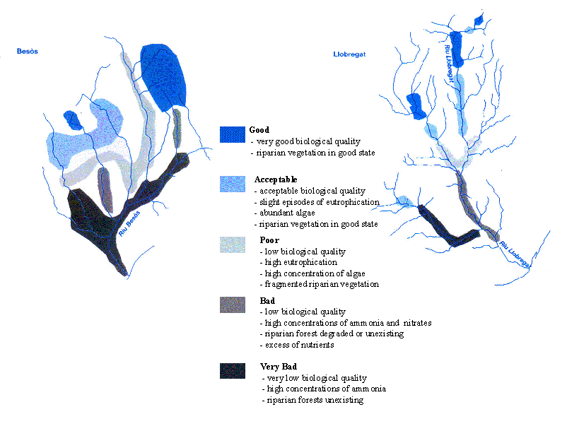
|
|  ecological
status of Foix and Tordera ecological
status of Foix and Tordera

|
stakeholders
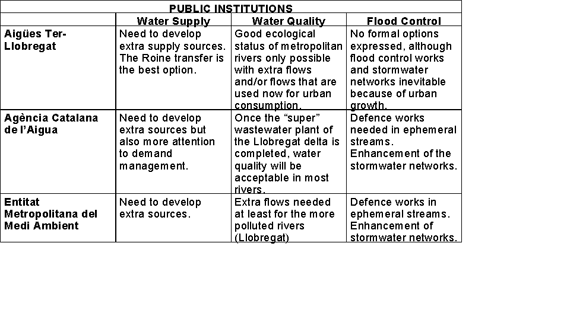
../new images/arrowup.gif
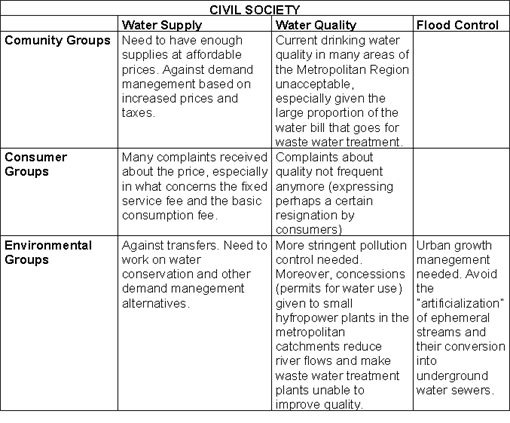
major
changes and pressures expected
- increase
in diffuse forms of urbanization - water demand
- differential
impacts of water prices. Are citizens of the central city subsidizing
citizens in surburbia
- possible
limits to the improvement of water quality
- possible
effects of land use changes (i.e. afforestation in the supply
basins) in water availabiilty
- possible
long-term effects on climate change (reduction of river flows
by 50% around 2050

|
|
